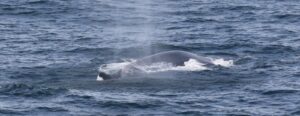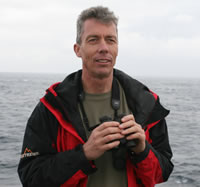By Peter Ryan, onboard scientist, expert in general ornithology, seabird-fishery interactions, evolutionary ecology, marine debris, solid waste management, biology of oceanic islands.
Leg 1, Day 21.
We continued steaming slightly south of east on the great circle route towards Hobart, crossing 54°S towards evening, as we approached 90°E. The ship made good speed in the calm weather (not living up to the fearsome reputation of the ‘furious fifties’). Few birds were about, but they were more and than made up for by the diversity of marine mammals, which are included in the list to bulk it up a bit. Fin Whales were abundant in the early morning, when King Penguins were scattered around with raised flippers and feet, presumably to help thermoregulate. The calm weather also facilitated sightings of species rarely seen at sea such as Elephant Seals. However, pride of place goes to a bird – the trip’s first Mottled Petrel. Arguably one of the most attractive of gadfly petrels (Pterodroma), it breeds on the Snares and islets off Stewart Island, and winters in the North Pacific Ocean, making it the only trans-equatorial migrant gadfly. In summer it ranges to south of 60°S throughout the eastern Indian and western Pacific sectors of the Southern Ocean. Hopefully it will become more common as we head farther east.
| Antarctic Prion | 100 | Diving petrel spp. | 12 |
| Wilson’s Storm Petrel | 10 | King Penguin | 8 |
| White-headed Petrel | 5 | Blue Petrel | 5 |
| White-chinned Petrel | 3 | Black-bellied Storm Petrel | 2 |
| Wandering Albatross | 1 | Northern Giant Petrel | 1 |
| Southern Giant Petrel | 1 | Mottled Petrel | 1 |
| Kerguelen Petrel | 1 | Hourglass Dolphin | 5 |
| Fin Whale | 15 | Unidentified whales | 5 |
| Bottle-nosed Whale? | 5 | Antarctic Fur Seal | 2 |
| Elephant Seal | 2 |
No litter was seen, but Bull Kelps Durvillaea antarctica were nearly as abundant as yesterday, with 36 pieces observed (albeit in 13 hours of transects).

